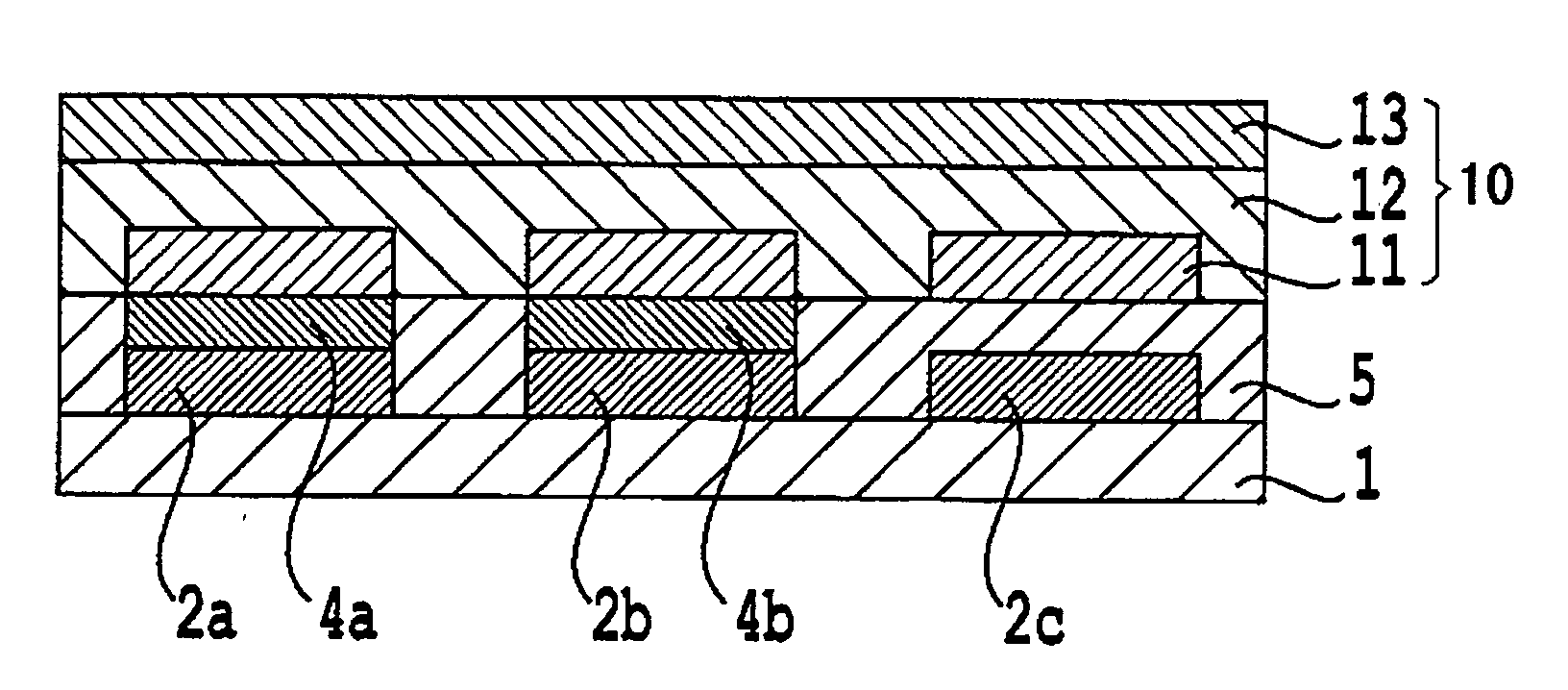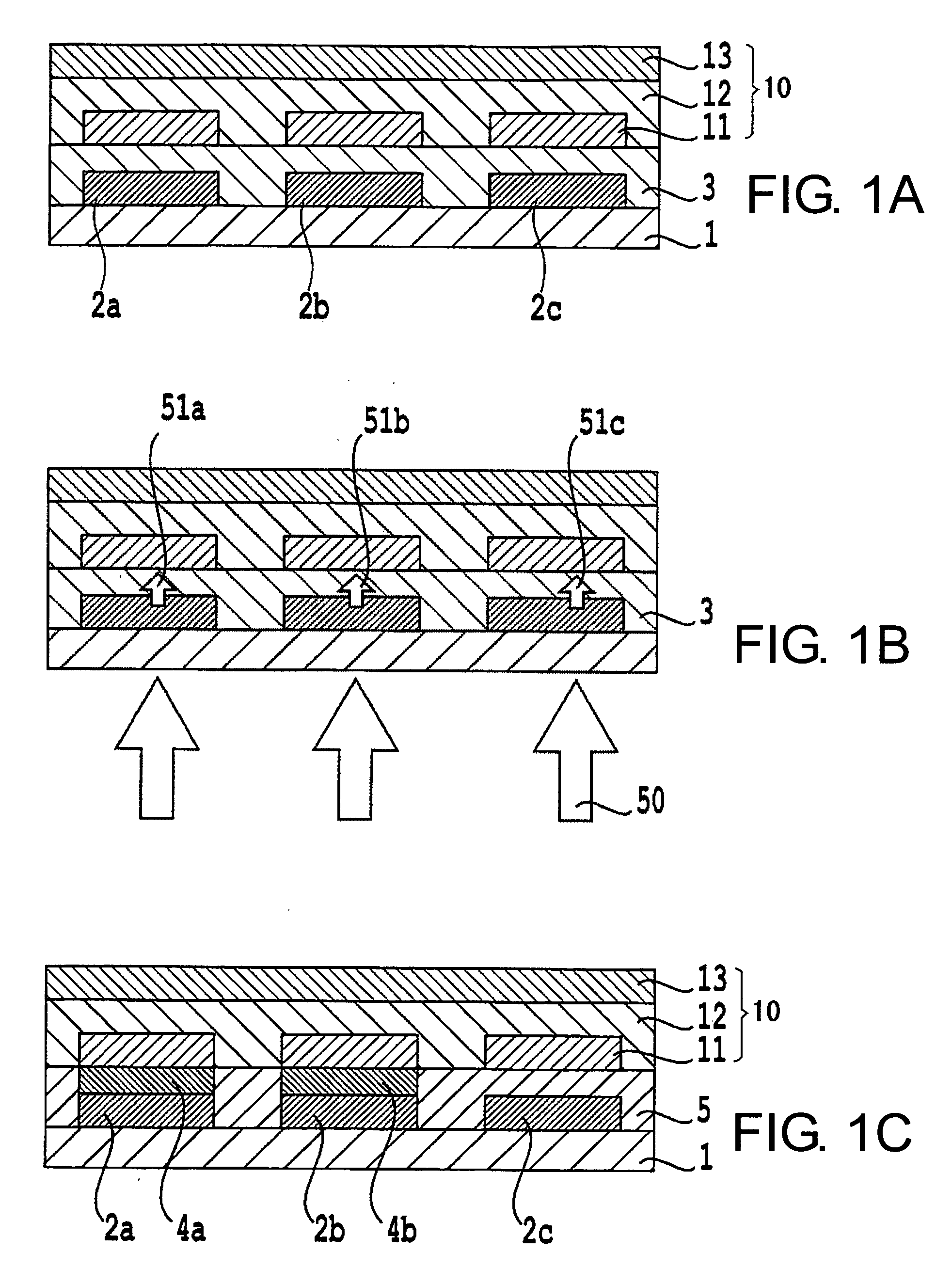Method of the manufacturing an organic EL display
a manufacturing method and technology of organic el, applied in the manufacture of electrode systems, final products, electric discharge tubes/lamps, etc., can solve the problems of pattern reproducibility, decomposition of color conversion dyes, and actual decrease of efficiency, so as to avoid color conversion layer distortion, shorten manufacturing steps, and high color conversion efficiency
- Summary
- Abstract
- Description
- Claims
- Application Information
AI Technical Summary
Benefits of technology
Problems solved by technology
Method used
Image
Examples
example 1
[0101] Blue color filter material (Color Mosaic CB-7001, a product of FUJIFILM Electronic Materials Co., Ltd.) was applied on a transparent glass substrate (Corning 1737 glass) by a spin coating method, and patterned by a photolithography method, to form a blue color filter layer of plural strips extending in the longitudinal direction having a line width of 0.1 mm, a pitch of 0.33 mm (distance between two adjacent lines being 0.23 mm), and a film thickness of 2 μm.
[0102] On the substrate having the blue color filter layer, a green color filter material (Color Mosaic CG-7001, a product of FUJIFILM Electronic Materials Co., Ltd.) was applied by a spin coating method, and patterned by a photolithography method, to form a green color filter layer of plural stripes extending in the longitudinal direction having a line width of 0.1 mm, a pitch of 0.33 mm, and a film thickness of 2 μm.
[0103] Next, a red color filter material (Color Mosaic CR-7001, a product of FUJIFILM Electronic Materi...
example 2
[0111] An organic EL display was manufactured in the same manner as in Example 1 except that a forward bias voltage of 10 V was applied on the organic EL layer, linearly and sequentially scanning the transparent electrode elements and the reflective electrode elements in the process of dye-decomposing light irradiation. In this example, the irradiation time of the dye-decomposing light was shortened by 30% as compared with in Example 1, demonstrating promotion of decomposition of the color conversion dye in the dye layer by the emission from the organic EL layer.
example 3
[0112] An organic EL display was manufactured in the same manner as in Example 2 except that the light emitting elements in the area corresponding to the red color filter layer was not lit in the process of the linear and sequential scanning of the transparent electrode elements and the reflective electrode elements. In this Example, also, as in Example 2, the irradiation time of the dye-decomposing light was shortened by 30% as compared with in Example 1, demonstrating promotion of decomposition of the color conversion dye in the dye layer by the emission from the organic EL layer.
PUM
 Login to View More
Login to View More Abstract
Description
Claims
Application Information
 Login to View More
Login to View More - R&D
- Intellectual Property
- Life Sciences
- Materials
- Tech Scout
- Unparalleled Data Quality
- Higher Quality Content
- 60% Fewer Hallucinations
Browse by: Latest US Patents, China's latest patents, Technical Efficacy Thesaurus, Application Domain, Technology Topic, Popular Technical Reports.
© 2025 PatSnap. All rights reserved.Legal|Privacy policy|Modern Slavery Act Transparency Statement|Sitemap|About US| Contact US: help@patsnap.com



